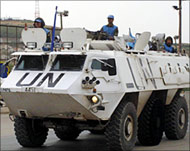Landmines still a threat in Lebanon
Landmine casualties in Lebanon have dropped dramatically in the past three years but the decline is too little too late.

According to official figures, Lebanon has some 550,000 anti-tank, anti-personnel mines and unexploded ordnance (UXO) planted nationwide, the legacy of a devastating 15-year civil war that ended in 1990, and a 22-year Israeli occupation of the country’s southern region.
Due to an aggressive awareness campaign, deaths and maimings have been reduced but lack of money and little information has made a final solution remain a distant hope.
Lieutenant Colonel Taki al-Din al-Tannir, in charge of mine awareness and information at the National De-Mining Centre, says casualty figures dropped from 78 civilians in 2000 (13 killed and 65 wounded), to “a minor injury” in the first quarter of 2004.
“This is due to the de-mining action and the rapidly spreading awareness among people. Our awareness campaign is working,” he told Aljazeera.net.
The campaign includes sessions given to residents of affected areas, school students and army personnel on the dangers of landmines and how to avoid them. The centre also produces posters, T-shirts and booklets and distributes them among schools.
Southern focus
“Eighty per cent of the landmines are located in the south and were planted by the Israeli occupation army,” says Staff Colonel Kasim Jammul, of the Mine Action Coordination Centre.
“This is a huge number for a small country like Lebanon.”
|
“We have a long fight ahead. We are facing a number of troubles, including the lack of detailed maps of landmines” Staff Colonel Kasim Jammul, |
Lebanese and Syrian army de-miners, along with commercial companies, the United Nations peacekeeping troops and a Ukrainian army battalion have cleared only 25km sq of the affected areas, while 115km sq, mostly in the south and across the border with Israel, are still contaminated and considered dangerous.
“We have a long fight ahead,” says Jammul. “We are facing a number of troubles, including the lack of detailed maps of landmines.”
In January, Hizb Allah (Party of God), the Lebanese movement that helped drive the Israelis out of the country, obtained maps of landmines planted by the Israeli forces in the south during an exchange of prisoners.
Al-Tannir, however, says they helped locate only a “handful” of mines.
Money worries
Funds, or the lack of them, are another problem.
According to the 2003 landmine monitor report, Lebanon received $24 million from donors, a huge jump compared to the $5.1 million received a year earlier but still far from the $50 million donated by the United Arab Emirates in 2001.
“Money will determine the length of our plan to clear Lebanon of landmines,” says Jammul. “If we continue receiving substantial donations every year, we will have a landmine-free country by 2010. Otherwise we’ll have to wait.”
 |
|
A UN armoured personnel carrier |
The existence of landmines has blocked several development and infrastructure projects, says Habbuba Aoun of the Landmine Resource Centre.
“Landmines, cluster bombs, UXO and booby-traps are mainly planted in agricultural areas and they have been slowing development projects such as al-Wazani irrigation project,” she added.
Asked why Lebanon is not a signatory to the international convention banning the production, export and stockpiling of landmines, Jammul said the “the current state of war with Israel prevents us from signing the treaty”.
“We are victims of landmines not producers, but we adhere to the spirit of the treaty.”